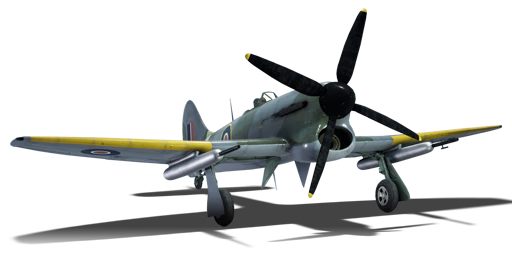



The Tempest Mk V (Vickers P) was a British prototype attacker developed from the Tempest Mk V at the end of the war. A single Mk V was rearmed with 47 mm Vickers Class P guns, and designated Tempest Mk V (PV). The 20 mm guns in wings were removed and a 47 mm gun was installed in a gunpod under each wing, carrying 38 rounds per gun. Tests revealed that the aircraft had potential, however no production was undertaken, partially due to the end of the war in Europe.
The Tempest Mk V (PV) was introduced in Update 1.37. The attacker variant of the Tempest fighter, it retains the majority of its speed despite the added drag from the gunpods, still being faster than its counterparts. The plane comes with two high velocity 47 mm guns able to penetrate all armour found at its BR with ease from the top, and also the sides of a majority of tanks. Due to the low fire rate of the guns, while it is entirely possible to hit fighters, it is not advised to rely on.
flaps
flaps
flaps
brake
| Belt | Belt filling | Armor penetration (mm) at a distance: | |||||
|---|---|---|---|---|---|---|---|
| 10 m | 100 m | 500 m | 1000 m | 1500 m | 2000 m | ||
| AP-T | 99 | 97 | 88 | 77 | 68 | 60 | |












Flight performance | |
|---|---|
Survivability |
|---|
Weaponry |
|---|